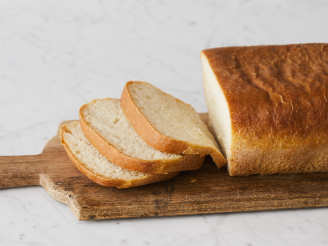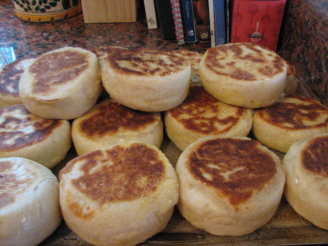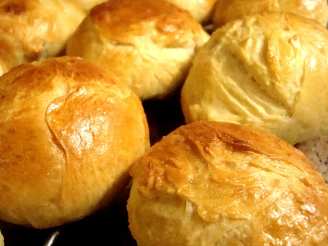Sourdough Bread
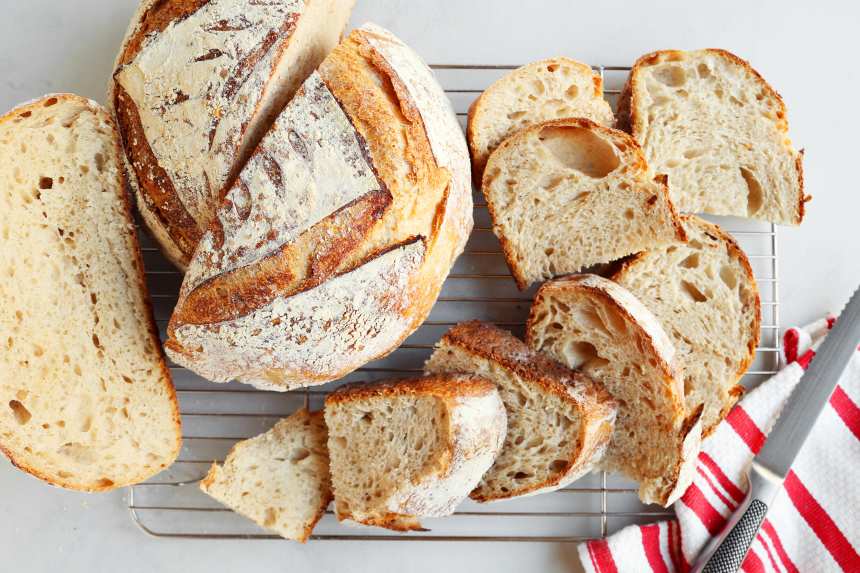
photo by Jonathan Melendez

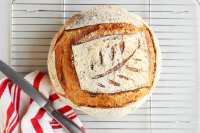
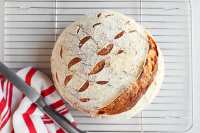


- Ready In:
- 24hrs 50mins
- Ingredients:
- 9
- Yields:
-
1 loaf
ingredients
-
Levain
- 25 g mature sourdough starter (Sourdough Starter)
- 25 g whole wheat flour
- 25 g bread flour
- 50 g water
-
Autolyse
- 450 g white bread flour
- 50 g white spelt flour
- 375 g water
- 10 g salt
- 4 g rice flour
directions
-
9:00AM (Day Before Baking):
- Make the levain by combining 25 grams mature starter, 25 grams whole wheat flour, 25 grams bread flour and 50 grams warm water (80°F), in a Mason jar, until well combined. Cover loosely with plastic wrap and store in a warm spot until it doubles in size, about 5 hours. I like to put it in the oven (no heat) with the light turned on.
-
12:00PM (Day Before Baking):
- About halfway through the levain's rising time, make the autolyse. In a large bowl, combine the bread flour, spelt flour and 350 grams of the water. Use your hands to squeeze the flour into the water until all of the flour has been hydrated. Use a plastic dough scraper to scrape any bits of the dough from your hands. At this point, we’re not looking for a smooth dough at all. We just want the flour hydrated with water. Cover loosely with plastic wrap and let rest alongside the levain.
-
2:00PM (Day Before Baking):
- This step of the process is called bulk fermentation. At this point your levain should have doubled in size. Measure out 100 grams of levain and add it to the autolyse. Use your hands to incorporate the two mixtures together by poking your fingers through the dough. Then you can start folding the dough unto itself until it becomes uniform. Let rest for 15 minutes. Then sprinkle in the salt and pour the remaining 25 grams water on top. Fold the dough onto itself until it comes together once again. You might find that the water and dough separate a bit but continue folding until the dough becomes uniform and soft.
- Cover loosely with plastic wrap and allow to rest in a warm spot until doubled in size, about 4 to 5 hours. This depends on the temperature of your kitchen and the temperature of your water. The best part about this recipe is that you don’t have to knead the dough too much. You just have to fold the dough onto itself a few times during this rest.
- Every 30 minutes uncover the dough and fold it onto itself by wetting your hands and going into one side of the dough and pulling and stretching it up and over onto itself. Do this a few times, rotating the dough each time. Cover, return to rest and repeat a few 4 to 5 more times during the bulk fermentation period.
-
7:00PM (Day Before Baking):
- Carefully transfer the dough onto a lightly floured work surface. Fold the dough onto itself from top to bottom and then side to side. Cover loosely and rest for 20 minutes. Flip the dough over and then shape into a round smooth ball as best as you can.
- Dust a proofing basket or large round bowl (lined with a clean kitchen towel) with rice flour. Rice flour doesn’t absorb into the dough, which will prevent it from sticking to the bowl. Transfer the dough into the prepared basket or bowl, round smooth side down. Cover loosely with plastic wrap and chill in the fridge overnight.
-
8:30AM (Morning Of):
- Place a 5 qt or larger dutch oven (with the lid) in the oven and preheat to 450°F for 1 hour.
-
9:30AM (Morning Of):
- Remove the dough from the fridge. Cover with a small piece of parchment paper and place a pizza peel or cutting board on top. Flip over and then remove the bowl from the top. Dust the top of the bread with a thin layer of bread flour. Use a sharp bread lame or sharp paring knife to cut a design on top.
- Using heavy-duty oven mitts, carefully remove the pot from the oven and uncover. Use the parchment paper to carefully transfer the bread (along with the paper) to the hot pot. Cover and bake for 20 minutes. Uncover and bake for another 30 minutes until deep golden brown and the internal temperature of the bread is 208°F.
- Remove the pot from the oven and carefully lift the bread out of the pot, using the parchment paper to grab it. Place on a wire rack and allow to rest for 1 hour before cutting and enjoying.
-
Useful Tools:
- Plastic dough scraper.
- Bread proving basket.
- 5 qt Dutch oven.
- Bread lame.
Reviews
-
This recipe and the accompanying “ How to make your own Soudough “. don’t quite match. The amounts of flour are missing in the above description. It would be nice. I’ll let you know how it turns out. Can I replace the spelt flour with another? Also it would be good if you provided photos of the stretching and folding process.
RECIPE SUBMITTED BY
Jonathan Melendez
North Hollywood, California
Jonathan Melendez is a passionate author, food photographer, cook, baker, and recipe developer whose blog, The Candid Appetite, has appeared prominently on such sites as, BonAppetite, People, Cosmopolitan, The Kitchn, Today, The Cooking Channel, Food52 and Joy the Baker. He has created and photographed recipes for Idaho Potato Commission, Wisconsin Milk Marketing Board, American Butter Institute and Jones Dairy Farm, to name a few. He lives in Los Angeles, CA.





